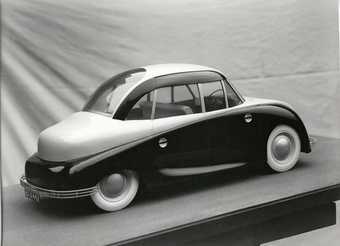
Model of Naum Gabo's car design, conceived for the Design Research Unit c.1943
Naum Gabo Collection, Tate Archive © Nina Williams
Held within the Tate archive is a series of photographs, drawings and notes that relate to Naum Gabo’s brief 1940s venture into car design. Conceived as a dramatically integrated form, the car appears more streamlined and aerodynamic than other British vehicles of that era, a curvilinear body with recessed door handles and headlights. Among the detail consistent with his sculpture from the period, Gabo employed a spiral motif in the grille and biomechanical forms such as a kidney-shaped steering wheel. His design incorporated a curved perspex windscreen and nylon upholstery – two new plastics he had begun to use elsewhere in his work.
The project was one of the first originated by the Design Research Unit, a loose association of architects and industrial and graphic designers that grouped together during the Second World War to form a new practice with Gabo’s friends, the critic Herbert Read and patron Marcus Brumwell. It sits at the beginning of the fascinating journey of an important but lesser-known initiative in the history of British design. The Design Research Unit was a socially minded operation whose roots lay in the first multi-disciplinary advertising firms of the 1920s and a chance grouping of individuals in the Ministry of Information. Its formation can be traced back to discussions in 1942 that produced some early notes proposing an advisory body of specialists serving government and trade alike that could be consulted on all aspects of design.
Anticipating a slow return to profit in the manufacturing industries, its members looked to address the post-war “problems of physical reconstruction”, aspiring to become involved in the “reconditioning and re-designing” of public utility services and (soon-to-be-nationalised) transport networks such as the railway companies.
Over the next three decades the group was responsible for some of the most iconic and comprehensive projects in national and corporate design. Under the leadership of Misha Black and Milner Gray, it produced signage, decoration and architecture for the 1951 Festival of Britain and a ten-part exhibition for the Dome of Discovery. In the 1960s and 1970s it designed everything from matchbooks to boardrooms for British Rail, ICI and Ilford and revolutionised the look of the English public house for the Watney Mann brewery. Black, an Azerbaijan- born architect without formal training who had founded the anti-fascist Artists International Association in 1933, and Gray, who had studied engraving at Goldsmiths with Graham Sutherland, sought to promote cross-disciplinary discussion through six-weekly design meetings, a tradition that continued into the 1970s when the creative staff numbered more than 50.
If their name has dropped out of currency, their design has not. Travelling around London you can trace the red and gold cockerel signs advertising Courage & Co hanging outside pubs and the yellow lamps on taxis to the 1940s work of Milner Gray. There are also the Westminster street name plates and designs for the first Victoria Line trains and stations: the 1960s work of Misha Black. And, perhaps the group’s most widely recognised emblem, the ubiquitous double arrow symbol that outlives the nationalised rail network: the work of a young Gerald Barney. Regrettably, Gabo’s car never reached production – the manufacturer Jowett deemed it a “radical” but impractical conceit. The Design Research Unit, however, lives on under the auspices of the Covent Garden-based firm of architects Scott Brownrigg.
